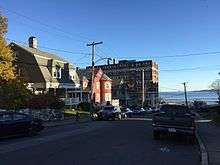Diamond Historic District (Lynn, Massachusetts)
|
Diamond Historic District | |
|
A large Victorian home in Lynn's Diamond District | |
  | |
| Location | Lynn, Massachusetts |
|---|---|
| Coordinates | 42°27′38″N 70°55′58″W / 42.46056°N 70.93278°WCoordinates: 42°27′38″N 70°55′58″W / 42.46056°N 70.93278°W |
| Built | 1837 |
| Architect | Betts, Thomas; Bixbee, C.A., et al. |
| Architectural style | Federal, Greek Revival, Gothic Revival |
| NRHP Reference # | [1] |
| Added to NRHP | October 10, 1996 |
The Diamond Historic District is a 69.5-acre (28.1 ha) National Register historic district in Lynn, Massachusetts. Established by the National Park Service in 1996,[1] the district is situated between downtown Lynn and the Atlantic Ocean, and includes 590 contributing resources. It is bounded, roughly, by Broad and Lewis Streets to the north, Lynn Shore Drive to the southeast, Nahant Street to the west, and Eastern Avenue to the east.[2]



Although the Washington Square section of Broad Street was first settled by Europeans in the 1630s, the oldest surviving structure in the Diamond District is the c. 1825 Daniel Newhall House. Most of the District's earliest surviving houses are conservative, 2.5-story, center-chimney Federal buildings, but several Greek Revival structures also are extant.[2]
The Diamond District was substantially developed after 1840, when the area became a fashionable coastal summer resort. Accordingly, mid- and late-19th century architectural styles dominate. The style best represented is Colonial Revival, with numerous exemplars built between 1890 and 1940--notably the Charles Lovejoy House, which was added to the National Register in 1978.[2] A significant number of Italianate, Queen Anne, and Second Empire houses also are present, including the Lucian Newhall Houses, which were added to the National Register in 1985. The American Shingle Style is also represented.
Although predominantly residential, the Diamond District includes a handful of commercial buildings, which are located on Broad and Lewis Streets,. The District also includes four religious structures. The oldest, a Quaker meetinghouse, was built c. 1825, while the other three--two churches and a synagogue--date to the early decades of the 20th century.[2]
See also
- National Register of Historic Places listings in Lynn, Massachusetts
- National Register of Historic Places listings in Essex County, Massachusetts
References
- 1 2 National Park Service (2008-04-15). "National Register Information System". National Register of Historic Places. National Park Service.
- 1 2 3 4 "NRHP nomination for Diamond Historic District". Commonwealth of Massachusetts. Retrieved 2013-12-22.

